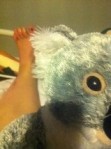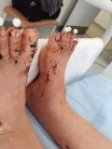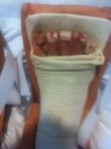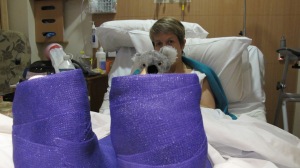(Scroll down for New Ground – Part One; beginning of full narrative starts with Finding my Feet)
On the morning of the second day in the rehabilitation hospital, Dr Ellis came by with what looked like a pair of household pliers. Without fuss or ceremony he began pulling out the thin metal pins that were holding my eight toes in a straightened position. I had been dreading this part, but it was over too quickly for me to register much fear. It was more ridiculous than painful to watch Dr Ellis work up sweat as he applied simple DIY techniques to my toes. A few simple plasters later, and there was no more metal in my toes, apart from that embedded permanently in the top joint of my big toes.
For my exercises on Day Two I graduated to sitting in a chair, practising lifting my foot by my tendon against the force of gravity. This was definitely a more challenging exercise than from a prone position in bed. But I was getting better at creating the mental pathway between my ‘request’ to my foot and the corresponding action. I no longer had to tap my foot with my finger to help my brain know what action I required of my tendon. I found that meditation and visualisation helped to make this new connection happen faster. As research in neuroscience shows, the brain is quite adept at finding new neural pathways – and my brain seemed to be picking up the new pathway fairly quickly.
On Day three, I was finally allowed to give me feet a good soak in water and salt so that the ‘elephant skin’, as I unlovingly called it, could be scrubbed off. I felt more prepared to have a good look at my feet than I had been on the first day. They still weren’t pretty, but the scars were fairly thin and neat. My feet were a little bit swollen but they were definitely shaped like normal feet: quite nice feet actually.

A poor mobile photo – with my ‘pet’ koala in the foreground – but it does show a scrubbed and much improved looking left foot!
Once thoroughly dried, I got to put runners on my feet for the first time and put my full weight on my feet. How incredibly strange! It felt like I was going to fall forward. I had not been conscious of the fact that for years I had held myself up on the backs of my heels, barely using the balls of my feet, toes or calves to hold myself upright. It was also drawn to my attention – by my astute and eagle-eyed physiotherapist, Sylvia – that I was continuously bending my knees rather than standing straight. I had not realised that I kept a bend in my knees to retain my balance. Now that I was practising my foot motion from an upright position, I had to re-learn standing! My inner thigh muscles were weak as I had been using my outer thigh muscles, walking as I had on the outsides of my feet to compensate for my high arches. But where I once in regular fear of going over on my ankles, they now felt as if it would be quite difficult for them to go over. And it felt incredible to feel so much more of the floor under my feet. I was literally more grounded to the earth!
There was to be no real walking for me yet. First it was ‘baby’ marching, practicing the foot lift motion as the first thing I did in a step. Again, this was new learning for me and my whole body. For years, largely unconsciously, I have begun my steps by swinging my leg out to achieve forward momentum; on my left side especially, my weak tendon did not have the strength to pull my foot up. That is why people often assumed the issue was in my hip or leg. Even though my small exercises did not look like much, and even though I was a far cry from my original expectations, it was exciting to have a strong set of tendons that were doing the job they were supposed to. And they were doing it well!
It wasn’t until the second week of rehab that I started the experiment of walking. Bear in mind, I was still making full use of my crutches. My balance was weak and I couldn’t imagine letting them go. But my various physiotherapists – all of whom had been educated in CMT and the re-training process by Drs Ellis and Warren – also insisted that I use the crutches to promote the correct gait. And re-training meant that I was taking very small steps. With every step, I was practicing pulling up my foot and holding it up until it came back down to earth. But I also had to remember to straighten my legs which were nervous about this new walking style and inclined to bend. Walking in my previous life was always fraught with the real risk of tripping or losing my balance – so my knees were use to being ready! The process was more mentally than physically exhausting. As Sylvia noted, the ultimate goal was to ‘forget’ about walking!
As I neared the end of my stay in Hirondelle, it became clear that my original image of walking out of the doors like a normal person was out of line with the reality. One person had excitedly told me I would be “dancing” when next I saw her. I was still a far cry from dancing and was continuing to reconcile emotionally with the journey ahead of me. I was now walking, and without either crutch for short periods, but it was rather slow going and tentative.
However, I had gained huge ground from the moment when the casts were loosed from my feet, two weeks earlier. I was being released into the big world of obstacles and uneven ground with my new feet to take me forward. There was still much work to do, but it was now largely up to me to carry on the challenging task of re-educating my tendons, feet, legs, muscles and brain. After all, we all start in this world with baby steps.



